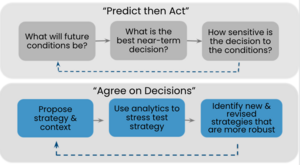Robust decision making
Abstract
Managing and planing projects or portfolios includes making big decision often based either on a very limited knowledge base, or an uncertain future - or both. Dealing with a great set of unknowns and uncertainties requires a skill set to make decisions making outcomes robust enough to cope unexpected futures and new disrupting knowledge. This is where Robust decision making proves its importance. Robust decision making (RDM) is a framework for decision making that take the uncertainty of different futures into consideration and helps the decision maker to reach his/her end goals by making decisions strong enough to fit a wider range of future scenarios. Rather then questioning the different future scenarios, the methodology of RDM focuses on what actions can be done at the present in order to improve future stands. Dealing with project, program and portfolio management, RDM is a vital methodology frome the beginning where information can be limited, all the way to the end stage of a project where gained knowledge have the potential to disrupt previous made discions.
Histrory
As with many technologies and scientific approaches, RDM has its origin from military activities. In the early 1980's, when the Cold War was reaching its terminating, the RAND corporation was using simulation models designed to predict the potential outcome of different strategies. (file:///Users/patricklaybourn/Downloads/1007261%20(1).pdf). At this stage of time, the methodology of RDM was not very well developed and RAND's predictions not very accurate. It was not until the early 1990's when the two RAND analysts Robert Lempert and Steven Popper further evolved the methodology framework in cooperation with RAND Computer Scientist Steve Bankes. The methods of RDM has been used ever since in an increasing manner on a wide range of different problematics of a very high degree of uncertainty including defense, flood risk management and climate change. (https://millennium-project.org/wp-content/uploads/2020/02/22-Robust-Decisionmaking.pdf)
RDM VS traditional risk management
The use of a traditional risk management approach can prove very effective and often bring good results. These approaches are limited though, as they only work well when uncertainty is well addressed. The methodology of traditional risk accesment comes in a number of different variations, but generally share a distinct pattern knowns as "predict-then-act". This approach follows the method illustrated in picture 1. The approach first asks the question: "What will future conditions be?" and based in the information gained from this question, the next question: "What is the next near-term decision?" is asked. At the end, a final question in the form of a sensitivity analysis is asked: "How sensitive is the decision on the conditions?". However, the "predict-then-act" approach can prove valuable, it only holds its strength when the future is not changing and is not difficult to predict. In situations of severe uncertainty, using a traditional risk accesment approach often lead to an underestimation of uncertainties as an optimal decision otherwise would be hard to find. It is the search of the optimal solution that limits the "predict-then-act" methodology, as it does not account well enough for other outcomes.RDM adresses the tendency of narrow-mindedness that traditional risk accesment can have. RDM "flips" the order of step in the "predict-than-act". As visualized in picture 1, the approach that RDM takes, often called the bottom-up analysis, starts by looking at the proposed strategies. The next step is to address the vulnerabilities of these strategies and access whether or not they meet the set goals. The third and final step is to alterate the initial strategies identified in step one with respect to the vulnerabilities identified in the second step. These steps are iterated over a number of times until a robust strategy is reached.
Contents:
1. History
2. Applications 3. RDM VS traditional risk management
Conditions of use Robust decision making Framework
3. Analytic tools
XLRM Framework
4. Limitations of Robust decision making 5. References
1. Vincent A. W. J. Marchau, Warren E. Walker, Pieter J. T. M. Bloemen, Steven W. Popper, "Desicion Making under Deep Uncertainty" 2. Lempert, Robert J; Popper, Steven W; Bankes, Steven C., "Robust Decision Making: Coping with Uncertainty",
